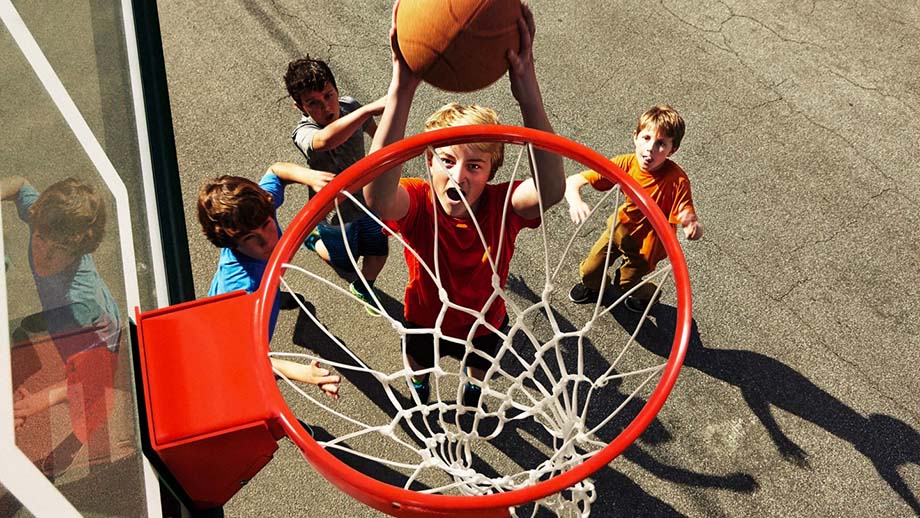In an era dominated by screens, childhood obesity rates are climbing, leading many children towards a sedentary lifestyle. Installing a basketball hoop at home can counteract this trend by encouraging physical activity. Not only does basketball offer fun and entertainment, but it also provides significant health benefits like improved cardiovascular health, better hand-eye coordination, muscle growth, and enhanced mental focus. This comprehensive activity can help lay a foundation for a healthier, more balanced life for children, steering them away from excessive screen time.
Table of Contents
Making outdoor Physical Activity Appealing
Engaging kids in physical activity becomes a joyful experience with a home basketball hoop that adjusts from 10 feet down to 5 feet, allowing children to emulate their basketball idols. This setup not only motivates them to step outside and play but also contributes to their physical health by improving cardiovascular fitness, coordination, and muscle strength. Additionally, it enhances cognitive functions, which can positively affect academic performance. This approach offers a non-confrontational method to introduce children to a healthier, more active lifestyle.

Revving Up Motivation, From Couch To Court With a Basketball Hoop for Children
Let’s explore 8 effective strategies to inspire your children to switch from screen time to court time, trading their digital devices for basketball dribbles.
1 Be the Change: Inspire Through Action
Be Active Yourself: Children are strongly influenced by what they see around them.
Diversify Fitness: Encourage participation in many forms of activity.
Embody the active lifestyle you want your children to adopt. Kids learn by example, so when they see you actively participating in basketball or other physical activities, they’re more likely to get excited about being active too. Keeping your basketball area clean and welcoming further encourages regular use.
Fostering Active Family Traditions
Establish and maintain active family traditions that revolve around physical activities like basketball. These aren’t just exercises; they’re opportunities for bonding and imparting valuable lessons about teamwork, perseverance, and enjoyment of physical activity. Regular family games can teach children important social and life skills in a fun, engaging environment.
Broadening the Scope of Physical Activities
Extend the concept of active living beyond the basketball court by incorporating various forms of physical activities such as hiking or cycling into your family’s routine. This variety helps everyone appreciate the many ways to stay healthy and active, enriching your family’s life with diverse and enjoyable physical experiences.
For those seeking guidance on integrating sports into family life or selecting the right basketball equipment, resources like our guides on choosing professional-grade basketball hoops or pertinently for younger children, Height Adjustable Basketball Hoops: Elevate Your Game at Any Age can be invaluable. These tools not only help you pick suitable equipment but also emphasize the importance of making sports accessible and enjoyable for kids of all ages.
2 Creating a Welcoming Play Area for Kids’ Basketball
Invest in a Professional Grade Hoop: A sturdy, professional-grade hoop can make a significant difference.
Maintain the Court: Keep the area clean, inviting and in good condition.
Transforming an outdoor space into a basketball haven involves more than just setup; it means creating a vibrant, appealing environment for young players. A high-quality, sturdy hoop, like those from professional grades, acts as the centerpiece, bringing life to any space, from backyards to community centers. It’s about turning a simple play area into a dynamic arena for both enjoyment and physical activity.
Essential Maintenance for Safety and Appeal
Keeping the basketball area well-maintained ensures it’s always ready for the next game. Regular cleaning, checking for stability, and making sure the playing surface is safe from hazards are crucial to keeping the space inviting and safe. A well-cared-for play area not only encourages frequent use but also instills a lasting appreciation for the game among its young players.
Tailoring Spaces for Every Environment
The concept of creating a welcoming play space applies universally, whether it’s in a private home or a public facility. Each environment should cater to its athletes, providing a setting that is not only functional but also enriches the playing experience. This could mean integrating the hoop into diverse settings, ensuring it complements the area and meets the needs of its users.
Designing the Ideal Play Space
The goal is to craft a play area that serves as more than just a sports space; it should be a cornerstone of fitness, that promotes active living and brings people together. It’s about creating a place that encourages sportsmanship, fosters social interactions, and build healthy lifestyles around the joy of basketball. When you’re ready to create your dream court, check out our guide on 5 Tips On Selecting The Perfect Basketball Hoop Location.
3 Encouraging Active Play Through Competitions and Rewards
Skill-based Rewards: Set up challenges and offer rewards.
Tournaments: Organize mini-tournaments with your kid’s friends or siblings.
Motivating children to actively participate in basketball involves more than just routine practice. It’s about transforming their effort into an exciting, rewarding experience. Introducing skill-based challenges and mini-tournaments not only makes practicing basketball more engaging but also nurtures a competitive spirit.
Cultivating a Healthy Competitive Atmosphere
Creating opportunities for children to earn rewards through skill-based challenges can make each basketball session feel more like a game and less like a chore. For example, setting up small contests where children can earn rewards for achieving specific skills or performance milestones keeps them interested and eager to improve.
Hosting mini-tournaments offers a fun way for kids to experience the thrill of competition while learning valuable life skills like teamwork and resilience. These tournaments, whether held in your backyard, at school, or in community sports facilities, can be tailored to the age and skill level of the participants. They’re about more than just winning; they’re about engaging with peers, celebrating progress, and applying skills in real-life scenarios.
Social Benefits and Team Building
These activities foster social interaction, allowing kids to practice communication and strategic thinking on the court. Organizing these events encourages children to work together, plan game strategies, and support one another, enriching their social and emotional development.
By strategically incorporating these elements into your child’s basketball activities, you can create a dynamic environment that promotes both physical skill and personal growth, making every dribble and shot count towards building a healthier, more active lifestyle.
4 Structured Learning Elevates Basketball Skills and Social Development
Structured Learning: Clinics and camps can boost skills and confidence through structured learning.
Social Interaction: Build friendships and foster teamwork through peer interaction.
Structured learning in basketball, through clinics and camps, is vital for nurturing a child’s skills and overall growth. These programs go beyond basic dribbling or shooting drills, offering a well-rounded educational experience that blends physical training with important life skills. Participants benefit from expert coaching, which tailors feedback and drills to individual needs, fostering technical proficiency and personal development.
Comprehensive Benefits of Structured Basketball Programs
- Expert Coaching: Trained professionals provide insights into basketball techniques, offering personalized guidance.
- Skill Enhancement: Comprehensive curricula challenge players to grow at every skill level, enhancing their capabilities across various aspects of the game.
- Social Interaction and Teamwork: Players learn to communicate and cooperate, essential skills that transcend the basketball court.
- Discipline and Work Ethic: Regular sessions instill discipline and the value of hard work, qualities that contribute to success both on and off the court.
“Coach Maitland’s Visit to Stamford Junior Knights”: A Case Study in Structured Learning
Our feature on Coach Maitland’s Visit to Stamford Junior Knights, delves into the transformative impact that structured basketball programs can have on young players.
Structured programs not only hone athletic skills but also build confidence, discipline, and self-esteem among young players. They emphasize the importance of persistence and teamwork, preparing children for a variety of life’s challenges. These settings also offer children a platform to forge friendships and develop social skills in a supportive environment. Through such immersive experiences, children gain a holistic understanding of both basketball and its broader life lessons.
5 Collaborate In Setting and Tracking Goals
Skills Development: Work with your child to set skill development goals.
Track Progress: Use charts or apps to monitor their progress.
Setting goals with your child in sports like basketball can significantly influence their motivation and growth. It involves creating specific targets, like improving dribbling skills or shooting accuracy, which makes progress tangible and meaningful.
The Benefits of Collaborative Goals
- Shared Commitment: Engaging with children in goal-setting fosters a sense of partnership, increasing their commitment and enthusiasm for the sport.
- Positive Reinforcement: Celebrating small successes builds confidence and reinforces the importance of consistent effort and perseverance.
Tracking Progress for Continuous Improvement
Using tools like charts or apps to track progress is crucial. It provides a visual representation of improvement, encouraging continuous effort and allowing adjustments to challenges as skills develop. This process not only keeps children engaged but also helps them understand the value of setting and achieving goals.
Sustaining Engagement through Positive Feedback
Regular feedback and positive reinforcement help children associate their efforts with personal achievement and satisfaction. This approach encourages a resilient attitude toward challenges, emphasizing the importance of hard work over innate talent.
By integrating these practices, you not only enhance your child’s athletic skills but also instill important life lessons, fostering a growth mindset that benefits all areas of their lives.
6 Make It Social With The Joy of Shared Play
Invite Friends: Encourage your kids to bring their friends over for a game.
Create or Join a Neighbourhood League: This can help with regular practice and the benefits of competition.
Encouraging children to play basketball with friends or join neighborhood leagues can transform the sport from an individual activity to a communal event. This shift not only makes the game more enjoyable but also promotes the development of social skills and fosters a sense of community among players.
The Benefits of Social Play
- Enhanced Fun: Playing with friends increases enjoyment and motivation.
- Skill Development: Competing with others helps improve sportsmanship and basketball skills.
- Community Building: Organizing games or leagues strengthens local bonds and creates a supportive environment.
Structured Competitions and Casual Meetups
Hosting mini-tournaments or casual games on your home court or local community centers can offer regular, structured play that combines the thrill of competition with the fun of social interaction. These events are opportunities for children to apply their skills in real-game scenarios, which is essential for their growth in the sport.
The Role of Educational and Sports Organizations
Schools and clubs are pivotal in providing structured environments for social sports. They organize teams, facilitate regular practices, and host tournaments, all of which are crucial for nurturing a child’s sportsmanship and team-playing abilities.
Creating Lasting Community Connections
By integrating basketball into children’s social lives, you’re not only enriching their sporting experience but also embedding them within a supportive network. This community-oriented approach to basketball can teach valuable life lessons about teamwork, respect, and the importance of contributing to something outside of themselves.
The Impact of Shared Experiences
Through basketball, children learn to communicate, collaborate, and respect each other’s abilities. These interactions are fundamental in building their confidence and helping them understand the value of teamwork, which are skills that will benefit them throughout their lives.
7 Understanding the Benefits and Comprehensive Advantages of Basketball for Youth
Healthy Discussion: Talk about the health benefits of regular physical activity.
Life Skills: Communicate how sports teach essential life skills.
Exploring the wide-ranging benefits of basketball helps foster a lasting appreciation for the sport and active lifestyles in general. This understanding should extend beyond physical health to include the mental, emotional, and social benefits that come from regular play.
Highlighting Physical Health Benefits of Basketball
Emphasize the direct health benefits: enhanced cardiovascular fitness, stronger muscles, improved coordination, and greater flexibility. Discuss how these physical benefits contribute to overall health and can prevent chronic conditions in the future, reinforcing the importance of forming healthy habits from a young age.
Mental and Emotional Health
Basketball isn’t just a workout for the body, so explain how basketball acts as a mental exercise, improving cognitive functions like concentration and decision-making while also offering emotional benefits such as stress relief and increased self-esteem..
Life Lessons and Personal Development
Highlight how basketball teaches essential life skills including teamwork, communication, and leadership. Use real-life stories or examples to demonstrate these skills in action, helping children see the practical applications of what they learn on the court.
Promoting a Healthy, Active Lifestyle
By educating kids on the benefits of basketball, you not only motivate them to engage more in the sport but also help them understand how physical activity enriches their lives. This knowledge, supported by positive experiences and a nurturing environment, lays the foundation for a healthy lifestyle that emphasizes personal growth and overall well-being.
8 Limiting Screen Time to Foster an Active Lifestyle
Setting Boundaries: Establish designated times away from screens.
Breaktimes: Encourage 15 minutes outside for every hour spent on devices.
Setting Clear Boundaries
Setting clear boundaries for screen use is crucial in promoting a balanced lifestyle for children. Creating a family plan that details screen time rules helps everyone understand and adhere to these guidelines, fostering healthier daily habits.
Encouraging Active Breaks
To counteract the sedentary nature of screen time, encourage active breaks. Suggesting short periods of physical activity, like basketball, for every hour spent on a device can integrate movement into your child’s routine, making physical activity a regular part of their day.
Basketball as an Alternative to Screens
A home basketball hoop serves as an inviting alternative to digital devices, offering both fun and physical benefits. Encouraging children to play basketball instead of screen time promotes physical health, enhances social skills, and supports mental development.
Supportive Family Environment
Promoting active lifestyles involves more than limiting screen time; it also means creating a supportive environment that values physical activity. Sharing experiences and celebrating active pursuits as a family can reinforce the importance of being active, helping children develop a preference for engaging in sports and other physical activities over sitting in front of screens.
By effectively managing screen time and promoting active alternatives like basketball, you can help your children lead healthier, more balanced lives. This approach not only enhances their physical and mental health but also enriches their social interactions and overall well-being.
Investing in Your Home and Health with Basketball
Encouraging physical activity, especially basketball, plays a pivotal role in enhancing the overall well-being of children. While digital devices have their time and place, maintaining a balanced lifestyle is essential. Installing a professional-grade basketball hoop at home transcends mere sports; it’s an investment in your family’s health, growth, and unity. Give your family the ultimate advantage by adding a basketball hoop to your backyard, promoting not only physical activity but also lifelong health and joyful family bonding.”





